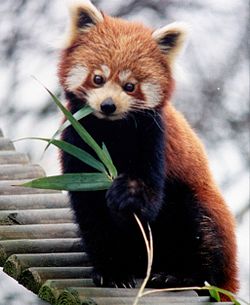Ailuridae Especies fósiles Referencias Enlaces externos Menú de...
AiluridaeFamilias de mamíferos
††††††††familiamamíferosordenCarnivorapanda rojogénerosextintos
Ailuridae | ||
|---|---|---|
Rango temporal: Oligoceno-Reciente PreЄ Є O S D C P T J K Pg N | ||
 Panda rojo | ||
| Taxonomía | ||
Reino: | Animalia | |
Filo: | Chordata | |
Clase: | Mammalia | |
| Subclase: | Eutheria | |
| Superorden: | Laurasiatheria | |
Orden: | Carnivora | |
| Suborden: | Caniformia | |
| Superfamilia: | Musteloidea | |
Familia: | Ailuridae Gray, 1843 | |
| Genera | ||
Actiocyon (†) | ||
Los ailúridos (Ailuridae) son una familia de mamíferos del orden Carnivora. La familia incluye al panda rojo y otros géneros extintos.
Especies fósiles
Además de Ailurus, la familia Ailuridae incluye ocho géneros extintos, muchos de los cuales fueron clasificados en dos subfamilias, Ailurinae y Simocyoninae.[1][2][3][4]
Familia Ailuridae
- Género Amphictis (†)
- Género Protursus (†)
Subfamilia Ailurinae
- Género Ailurus
- Género Magerictis (†)
- Género Parailurus (†)
- Género Pristinailurus (†)
- Género Ailurus
Subfamilia Simocyoninae (†)
- Género Actiocyon (†)
- Género Alopecocyon (†)
- Género Simocyon (†)
Referencias
↑ McKenna, MC & Bell SK (1997). Classification of Mammals Above the Species Level. Columbia University Press.
↑ Peigné, S., M. Salesa, M. Antón, and J. Morales (2005). «Ailurid carnivoran mammal Simocyon from the late Miocene of Spain and the systematics of the genus». Acta Palaeontologica Polonica 50: 219-238.
↑ Salesa, M., M. Antón, S. Peigné, and J. Morales (2006). «Evidence of a false thumb in a fossil carnivore clarifies the evolution of pandas». Proceedings of the National Academy of Sciences 103: 379-382. PMID 16387860. doi:10.1073/pnas.0504899102.
↑ Wallace, SC & Wang, X (2004). «Two new carnivores from an unusual late Tertiary forest biota in eastern North Americ». Nature 431: 556-559. doi:10.1038/nature02819.
- Davis, Davis D. (1964). “The Giant Panda: A Morphological Study of Evolutionary Mechanisms.“ Zoology Memoirs. Vol. 3:1-339.
- Decker D.M. and W.C. Wozencraft. (1991). “Phylogenetic Analysis of Recent Procyonid Genera.“ Journal of Mammalogy. Vol. 72 (1): 42-55.
- Flynn, J.J. and G.D. Wesley Hunt. (2005a). “Carnivora.“ in The Rise of Placental Mammals: Origin, Timing and Relationships of the Major Extant Clades, by D. Archibold and K. Rose. Baltimore. ISBN 0-8018-8022-X
- Flynn, John J., et al. (2005b). “Molecular phylogeny of the Carnivora (Mammalia): ASS-ASS the impact of increased sampling to on resolving enigmatic relationships.“ Systematic Biology. Vol. 54 (2):1-21. [1]
- Flynn, John J. Flynn, Michael A. Nedbal, J.W. Dragoo, and R.L. Honeycutt. (1998) "Whence the Red Panda?" Molecular Phylogenetics and Evolution. Vol. 17, No. 2, November 2000, pp. 190-199. [2]
- Glatston, A.R. (1989). Talk Panda Biology. The Hague. ISBN 90-5103-026-6
- Glatston, A.R. (compiler) (1994). “The Red Panda, Olingos, Coatis, Raccoons, and their Relatives: Status survey and conservation action plan for Procyonids and Ailurids.”
- IUCN/SSC Mustelid, Viverrid, and Procyonid Specialist Group. IUCN/SSC, Gland, Switzerland.
- Gregory, W.K. (1936). “On the Phylogenetic Relationships of the Giant Panda (Ailuropoda) to other Arctoid Carnivores.“ American Museum Novitates. Vol. 878:1-29.
- Hu, J.C. (1990). “Proceedings of studies of the red panda.” Chinese Scientific Publishing, Pekín, China.
- Wilson, Don E. and DeeAnn M. Reeder. (2005). Mammal of Species of the World. Johns Hopkins University press. ISBN 0-8018-8221-4.
Enlaces externos
 Wikimedia Commons alberga una categoría multimedia sobre Ailuridae.
Wikimedia Commons alberga una categoría multimedia sobre Ailuridae.
 Wikispecies tiene un artículo sobre Ailuridae.
Wikispecies tiene un artículo sobre Ailuridae.
.mw-parser-output .mw-authority-control .navbox hr:last-child{display:none}.mw-parser-output .mw-authority-control .navbox+.mw-mf-linked-projects{display:none}.mw-parser-output .mw-authority-control .mw-mf-linked-projects{display:flex;padding:0.5em;border:1px solid #c8ccd1;background-color:#eaecf0;color:#222222}.mw-parser-output .mw-authority-control .mw-mf-linked-projects ul li{margin-bottom:0}